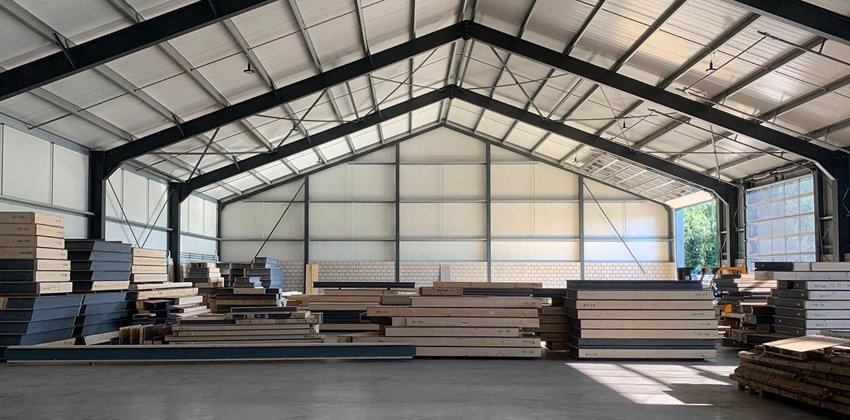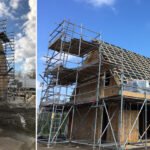
From R-Value to U-Value: Everything You Need to Know About SIP Insulation
Insulation is one of the most important factors in building performance, and in Europe it has become a decisive issue. Stricter building codes, higher energy costs, and climate-conscious buyers mean that insulation quality can determine the success of a project.
But when it comes to measuring insulation, confusion often arises. Two terms—R-value and U-value—are used widely, but their meaning and application differ across regions. For builders, architects, and developers, understanding how SIPs perform in both R- and U-value terms is essential for compliance, comfort, and marketing.
This blog explains the difference between R-value and U-value, how SIPs perform, and why airtightness and real-world results matter just as much as laboratory values.
What Is R-Value?
R-value measures thermal resistance—how well a material resists the flow of heat. The higher the R-value, the better the insulation.
- Formula: R = Thickness / Thermal Conductivity (λ)
- Units: (m²·K)/W in Europe, but often cited in ft²·°F·h/BTU in North America.
- Application: Commonly used in the United States, Canada, and some international standards.
R-value is useful for comparing insulation materials, but it only describes the resistance of a single layer, not the performance of an entire building element.
What Is U-Value?
U-value measures thermal transmittance—how much heat passes through a building element. Unlike R-value, lower U-values indicate better insulation.
- Formula: U = 1 / Total R-value of the element
- Units: W/(m²·K)
- Application: Standard across Europe and required in EU building codes.
U-value accounts for the entire assembly (wall, floor, or roof), including insulation, facings, and thermal bridges. This makes it more realistic for energy compliance.
SIPs in Terms of R- and U-Value
SIPs are a unique system because they combine structure, insulation, and airtightness in one panel.
- R-Value: SIP panels deliver high resistance thanks to their Neopor® core. For example, a 210 mm SIP wall can achieve an R-value of 6.5 (m²·K)/W.
- U-Value: The same wall achieves a U-value as low as 0.15 W/m²K, surpassing EU requirements for external walls.
Because SIPs are factory-laminated, their performance is consistent and predictable, unlike site-installed insulation that can suffer from gaps or compression.
Why Airtightness Matters
While R- and U-values measure thermal resistance, they don’t account for airtightness. Heat loss through air leakage can undermine even the best insulation.
SIPs excel here:
- Precision Joints: CNC cutting ensures tight fits.
- Sealed Connections: Proper detailing eliminates leaks.
- Blower Door Tests: SIP homes consistently achieve airtightness below 1.0 ACH (air changes per hour), supporting Passive House standards.
This means that in real-world conditions, SIP buildings often outperform their calculated values.
Comparing SIPs to Traditional Methods
- Brick and Block Walls: Require thicker construction and additional insulation layers to achieve the same U-values.
- Timber Frame Walls: More prone to air leakage, reducing real-world performance.
- Concrete Walls: Strong but poor insulators, requiring extensive insulation cladding.
SIPs combine structure, airtightness, and insulation in one step, reducing complexity and increasing performance.
Communicating Values to Clients
Architects and contractors often face the challenge of explaining insulation performance to clients who may be unfamiliar with technical terms. Here’s how to simplify it:
- “R-value measures resistance; U-value measures transmission.”
- “Higher R is better; lower U is better.”
- “SIPs give you both—excellent resistance and very low transmission.”
For clients, the bottom line is comfort, lower bills, and future-proof compliance with regulations.
Common Misconceptions
- “Thicker Is Always Better”: Not true. With Neopor® SIPs, thinner walls can achieve the same or better performance than thicker traditional assemblies.
- “R-Value and U-Value Are the Same”: They measure opposite concepts, but both are useful.
- “Lab Values Equal Real Performance”: Airtightness and installation quality matter just as much as material ratings.
Looking Ahead
As building codes tighten toward 2030, both R- and U-values will become even more critical. SIPs are well positioned to meet future standards because they deliver:
- Consistent Factory Quality
- Integrated Airtightness
- High Thermal Resistance in compact assemblies
- Compatibility with Passive House and nZEB requirements
Expect to see SIPs increasingly specified in projects where energy performance is non-negotiable.
Conclusion
Understanding insulation values is essential for building the homes of the future. R-value and U-value provide different perspectives on thermal performance, but both show the strength of SIPs. With high resistance, low transmission, and exceptional airtightness, SIPs deliver superior performance compared to traditional methods.
For architects, contractors, and developers, the message is clear: SIPs don’t just meet today’s energy standards—they exceed them, making them the smart choice for Europe’s future construction industry.





Add a comment